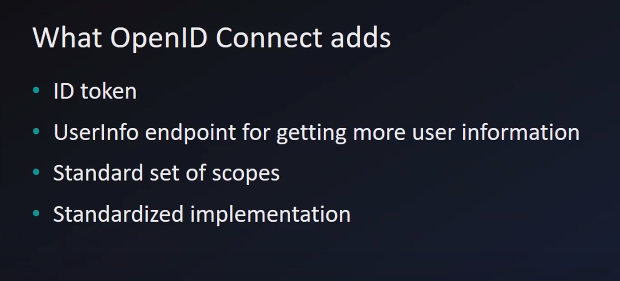SAML vs. OAuth
SAML (Security Assertion Markup Language) is an alternative federated authentication standard that many enterprises use for Single-Sign On (SSO). SAML enables enterprises to monitor who has access to corporate resources.
There are many differences between SAML and OAuth.
- SAML uses XML to pass messages, and OAuth uses JSON.
- OAuth provides a simpler mobile experience, while SAML is geared towards enterprise security.
- OAuth uses API calls extensively, which is why mobile applications, modern web applications, game consoles, and Internet of Things (IoT) devices find OAuth a better experience for the user. SAML, on the other hand, drops a session cookie in a browser that allows a user to access certain web pages – great for short-lived work days, but not so great when have to log into your thermostat every day.
OAUTH 2.0 Detailed Flow
See Solid/Broken Lines
OAUTH 2.0 Terminologies
OAuth Implicit Flow - See We actually handover Token directly over Front Channel 
Why We have "Authorization Code" and "Authentication Token" separate ?
- Back Channel - A very secure Channel - Backend to Backend
- Front Channel - A not very secure channel - Frontend to Backend
Overuse of OAUTH for Authentication? How to solve it ?
OAUTH for Authentication is a hack
OAUTH - is designed for Authorisation/Scope.
Social Login -> Google Login / Facebook Login -> Custom Solution - Overuse / Hack
Delegated Authorization - OAUTH - Solves it very Well
Designers of OAUTH Standard extended OAUTH and added Authentication capabilties and it became - OpenIDConnect
5-10% Extra Extension to OAUTH2.0 = OpenIdConnect
OAUTH - is designed for Authorisation/Scope.
Social Login -> Google Login / Facebook Login -> Custom Solution - Overuse / Hack
Delegated Authorization - OAUTH - Solves it very Well
Designers of OAUTH Standard extended OAUTH and added Authentication capabilties and it became - OpenIDConnect
5-10% Extra Extension to OAUTH2.0 = OpenIdConnect
AccessToken - OAuth2.0
IdToken - OpenIDConnect
User ---> OAUTH ---> SAML use case [OAUTH + SAML , Together]
References










